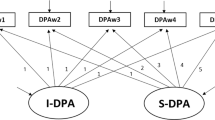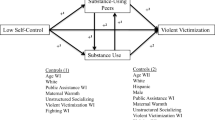Abstract
Pratt and Turanovic (European Journal of Criminology, 13(1):129–146, 2016) argue that previous studies operationalizing risky lifestyles as mere “going out” (problematic indicators of risky lifestyles) were misspecified and that “improved” indicators of risky lifestyle (risky behaviors) would perform better than “problematic” indicators in models that explain victimization. This study examines these propositions by testing the self-control/lifestyle framework of victimization using the data from a random sample of Filipino high school students at a state university in Dumaguete City, Philippines. Results show strong support to Pratt and Turanovic’s claims. Self-control has stronger effects on improved indicators than on problematic ones. And, improved indicators have stronger effects than problematic indicators on property, violent, peer/sibling and sexual victimization. Moreover, the findings provide partial support for the self-control/lifestyle framework of victimization.
Similar content being viewed by others
Notes
Note, however, that there have been studies conducted in the past using specific measures of risky lifestyles. For example, Mustaine and Tewksbury (1998) found that general measures of lifestyle (e.g. number of evenings spent away from home) are less important than specific measures (e.g. illegal behaviors) in predicting larceny victimization. See also other studies using specific risky lifestyle measures in the review by Spano and Freilich (2009).
The state university is currently offering a senior high school, because 2016 was the first year that the Philippines adopted a K+12 curriculum in basic education. And, higher education institutions (private and public) helped in the implementation by offering senior high schools, because the basic educational institutions do not have enough capacity to offer all programs in the senior high.
The school was selected due to logistical reasons. However, it may be a good site for testing the current models, because it has a good mix of students from different areas of the province. And, most of the students, who come from middle and lower social economic status, may have higher levels of risky lifestyles and lower levels of self-control compared to the students in the affluent schools in the city.
There were originally six items in this index. But, one item (i.e. hate crime victimization) was deleted. As one reviewer noted, hate crime victimization does not fit with the other violent victimization items, because it is largely determined by the victim’s status and not self-control or risky lifestyle. This was tested by building multivariate models, which show that none of the predictors significantly predict it.
Most researchers would point out a cut-off point of 0.70 alpha for reliability (allegedly) based on Jum Nunnally’ work on psychometric tests (Nunnally 1967; Nunnally 1978). However, Lance et al. (2006) posit that this criterion is a “myth,” as Nunnally did not specifically state a uniform, rigid criterion of 0.70. Nunnally sees a reliability standard as relative. For applied and basic research (where stakes are high such as in ability tests), it is desirable that measures have alphas of 0.90–0.95. But, for preliminary research, one can accept an alpha of 0.70 (Nunnally 1978) or even lower up to 0.50–0.60 (Nunnally 1967). Also, Kline (1999) stated that alphas lower than 0.70 are expected for psychological constructs (see also Field 2013) and are therefore acceptable.
References
Burt, C. H., Simons, R. L., & Simons, L. G. (2006). A longitudinal test of the effects of parenting and the stability of self-control: Negative evidence for the general theory of crime. Criminology, 44(2), 353–396.
Cho, S. (2017). Self-control and risky lifestyles in context: Cross-level integration between opportunity and collective efficacy in the study of peer victimization among South Korean youth. Journal of Child and Family Studies, 26(1), 67–79.
Cohen, L., & Felson, M. (1979). Social change and crime rate trends: a routine activity approach. American Sociological Review, 44, 588–608.
Coxe, S., West, S. G., & Aiken, L. S. (2009). The analysis of count data: a gentle introduction to Poisson regression and its alternatives. Journal of Personality Assessment, 91(2), 121–136.
Engel, C. (2012). Low self-control as a source of crime: a meta-study. Bonn: Max Planck Institute for Research on Collective Goods.
Field, A. (2013). Discovering statistics using IBM SPSS statistics and sex and drugs and rock ‘n’ roll (4th ed.). London: SAGE Publications Ltd.
Finkelhor, D., Hamby, S., Turner, H., & Ormrod, R. (2011). The juvenile victimization questionnaire: 2nd revision (JVQ-R2). Durham: Crimes Against Children Research Center.
Forde, D. R., & Kennedy, L. W. (1997). Risky lifestyles, routine activities, and the general theory of crime. Justice Quarterly, 14(2), 265–294.
Franklin, C. A. (2011). An investigation of the relationship between self-control and alcohol-induced sexual assault victimization. Criminal Justice and Behavior, 38, 263–285.
Gardner, W., Mulvey, E., & Shaw, E. (1995). Regression analyses of counts and rates: Poisson, overdispersed Poisson, and negative binomial models. Psychological Bulletin, 118(3), 392–404.
Gottfredson, M. R. (1981). On the etiology of criminal victimization. The Journal of Criminal Law and Criminology, 72(2), 714–726.
Gottfredson, M., & Hirschi, T. (1990). A general theory of crime. Stanford: Stanford University Press.
Grasmick, H., Tittle, C., Bursick, R., & Arneklev, B. (1993). Testing the core empirical implications of Gottfredson and Hirschi’s general theory of crime. Journal of Research in Crime and Delinquency, 30(1), 5–29.
Hindelang, M., Gottfredson, M., & Garofalo, J. (1978). Victims of personal crime: an empirical foundation for a theory of personal victimization. Cambridge: Ballinger.
Holtfreter, K., Reisig, M. D., & Pratt, T. C. (2008). Low self-control, routine activities, and fraud victimization. Criminology, 46, 189–220.
Kirby, S., Francis, B., & O’Flaherty, R. (2014). Can the FIFA World Cup football (soccer) tournament be associated with an increase in domestic abuse? Journal of Research in Crime and Delinquency, 51, 259–276.
Kline, P. (1999). The handbook of psychological testing. London: Routledge.
Lance, C. E., Butts, M. M., & Michels, L. C. (2006). The sources of four commonly reported cutoff criteria: what did they really say? Organizational Research Methods, 9(2), 202–220.
Messner, S. F., Lu, Z., Zhang, L., & Liu, J. (2007). Risks of criminal victimization in contemporary urban China: an application of lifestyle/routine activities theory. Justice Quarterly, 24(3), 496–522.
Mustaine, E. E., & Tewksbury, R. (1998). Predicting risks of larceny theft victimization: a routine activity analysis using refined lifestyle measures. Criminology, 36(4), 829–858.
Nisbett, R. E., Peng, K., Choi, I., & Norenzayan, A. (2001). Culture and systems of thought: holistic versus analytic cognition. Psychological Review, 108, 291–310.
Nunnally, J. C. (1967). Psychometric theory (1st ed.). New York: McGraw-Hill.
Nunnally, J. C. (1978). Psychometric theory (2nd ed.). New York: McGraw-Hill.
Pauwels, L. J. R., & Svensson, R. (2011). Exploring the relationship between offending and victimization: what is the role of risky lifestyles and low self-control? A test of two urban samples. Eur J Crim Pol Res, 17, 163–177.
Piquero, A. R., Jennings, W. G., & Farrington, D. P. (2010). On the malleability of self-control: theoretical and policy implications regarding a general theory of crime. Justice Quarterly, 27(6), 803–834.
Pratt, T. C. (2016). A self-control/life-course theory of criminal behavior. European Journal of Criminology, 13(1), 129–146.
Pratt, T. C., & Cullen, F. T. (2000). The empirical status of Gottfredson and Hirschi’s general theory of crime: a meta-analysis. Criminology, 38(3), 931–964.
Pratt, T. C., & Turanovic, J. J. (2016). Lifestyle and routine activity theories revisited: the importance of “risk” to the study of victimization. Vict Offenders, 11(3), 335–354.
Pratt, T. C., Turanovic, J. J., Fox, K. A., & Wright, K. A. (2014). Self-control and victimization: a meta-analysis. Criminology, 52(1), 87–116.
Ren, L., He, N. P., Zhao, R., & Zhang, H. (2017). Self-control, risky lifestyles, and victimization: a study with a sample of Chinese school youth. Criminal Justice and Behavior, 44(5), 695–716.
Reyes, J. (2015). Loób and Kapwa: an introduction to a Filipino virtue ethics. Asian Philos, 25(2), 148–171.
Schreck, C. (1999). Criminal victimization and low self-control: an extension and test of a general theory of crime. Justice Quarterly, 16(3), 633–654.
Schreck, C. J., Wright, R. A., & Miller, J. M. (2002). A study of individual and situational antecedents of violent victimization. Justice Quarterly, 19(1), 159–180.
Schreck, C., Stewart, E., & Fisher, B. (2006). Self-control, vicitmization, and their influence on risky lifestyles: a longitudinal analysis using panel data. Journal of Quantitative Criminology, 22, 319–340.
Spano, R., & Freilich, J. D. (2009). An assessment of the empirical validity and conceptualization of individual level multivariate studies of lifestyle/routine activities theory published from 1995 to 2005. Journal of Criminal Justice, 37, 305–314.
Stewart, E. A., Elifson, K. W., & Sterk, C. E. (2004). Integrating the general theory of crime into an explanation of violent victimization among female offenders. Justice Quarterly, 21(1), 159–181.
Tewksbury, R., & Mustaine, E. (2010). Cohen, Lawrence E., and Marcus K. Felson: Routine activity theory. In F. Cullen & P. Wilcox (Eds.), Encyclopedia of criminological theory (Vol. 1). Thousand Oaks: SAGE.
Tiangco, J. A. N. Z. (2005). Understanding the Filipino philosophy of resiliency: katatagang-loob [emotional strength/resiliency] and its phenomenological considerations. In R. M. Gripaldo (Ed.), Filipino cultural traits. Washington, DC: The Council for Research in Values and Philosophy.
Turanovic, J. J., & Pratt, T. C. (2014). “Can’t stop, won’t stop”: self-control, risky lifestyles, and repeat victimization. Journal of Quantitative Criminology, 30, 29–56.
Turanovic, J. J., Reisig, M. D., & Pratt, T. C. (2015). Risky lifestyles, low self-control, and violent victimization across gendered pathways to crime. Journal of Quantitative Criminology, 31, 183–206.
Funding
The author received no financial support for the research, authorship, and/or publication of this article.
Author information
Authors and Affiliations
Corresponding author
Ethics declarations
Conflict of Interest
The author declares no potential conflicts of interest with respect to the research, authorship, and/or publication of this article.
Ethical Compliance
All procedures performed in studies involving human participants were in accordance with the ethical standards of the institutional and/or national research committee and with the 1964 Helsinki declaration and its later amendments or comparable ethical standards.
Informed Consent
Informed consent was obtained from all individual participants included in the study.
Rights and permissions
About this article
Cite this article
Barrera, D.J. The Role of “Problematic” and “Improved” Indicators of Risky Lifestyles in the Self-Control/Lifestyle Framework of Victimization Among Filipino Adolescents. Asian J Criminol 13, 175–191 (2018). https://doi.org/10.1007/s11417-018-9265-1
Received:
Accepted:
Published:
Issue Date:
DOI: https://doi.org/10.1007/s11417-018-9265-1




